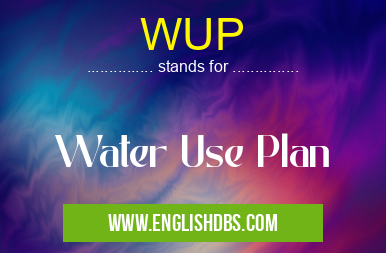What does WUP mean in COMMUNITY
Water Use Plan (WUP) is an important tool to ensure the sustainable use of water resources. It provides a comprehensive understanding of the current and future water-use needs and provides guidance for the effective management of this precious resource. WUPs are designed to identify strategies and actions that help protect, manage, conserve and develop water resources for present and future generations.

WUP meaning in Community in Community
WUP mostly used in an acronym Community in Category Community that means Water Use Plan
Shorthand: WUP,
Full Form: Water Use Plan
For more information of "Water Use Plan", see the section below.
Definition
A Water Use Plan (WUP) is a document that outlines how water resources should be managed within a given area or region. It details current and projected water use, identifies risks associated with excessive demand or inadequate supply, and proposes measures to address these issues. WUPs provide a systematic approach to managing both surface water (lakes, rivers) and groundwater sources, providing guidelines on how to sustainably allocate these resources among various users.
Benefits
A Water Use Plan can benefit many stakeholders by outlining goals and objectives for responsible resource use; it also allows policy makers to monitor the effectiveness of their decisions through regular monitoring programs. Furthermore, WUPs enable more efficient allocation of scarce resources by encouraging stakeholders to cooperate in developing mutually beneficial strategies that balance competing interests while considering environmental protection needs. Additionally, WUPs help promote public understanding of the importance of responsible resource management practices.
Essential Questions and Answers on Water Use Plan in "COMMUNITY»COMMUNITY"
What is a Water Use Plan?
A Water Use Plan (WUP) is a document that provides recommendations to improve the management and conservation of a specific water body. The plan covers all aspects of water use, including agriculture, industry, recreation, and human consumption. It also outlines strategies to monitor and protect the water body from potential future impacts.
What does a Water Use Plan include?
A WUP includes analysis and recommendations on reducing the impact of activities on the waterbody, including any existing regulations or laws governing its use. It also includes information on how best to manage the current uses of and pressures placed on it by humans and other activities that may influence its health. Additionally, it provides guidance on how to protect threatened species and ecosystems dependent upon the water body.
What are the most important elements of a Water Use Plan?
A WUP should include an assessment of existing threats to amend existing regulations or laws as well as identify potential new or emerging threats in order to ensure appropriate protection for valuable sources of drinking water. Strategies for monitoring changes in water quality, quantity and distribution should also be included in order to ensure early detection of problems before they become too severe. Finally, a WUP should address ways in which the public can be involved in planning for responsible stewardship of the resource.
Who creates a Water Use Plan?
A WUP is typically created by an expert or stakeholder group appointed by government agencies or local organizations charged with protecting resources. These groups often include representatives from various industries who rely on the particular source of water as well as community members who have an interest in its protection.
How long does it take to create a Water Use Plan?
The length of time required to create a WUP will depend on factors such as size and complexity of the particular resource being studied; availability data; legal requirements; availability funding; presence/involvement stakeholders; and more. Generally speaking, it could take several months up several years to complete one plan depending these variables.
Why do we need a Water Use Plan?
Implementing effective programs for monitoring surface waters; knowing limitations due to drought conditions; making informed decisions about granting permits for industrial activities near waterways; managing conflicts over access to available resources — these are only some reasons why having an up-to-date Water Use Plan is so important.
Is there one type of plan that fits all situations for issues related to water use?
No, each watershed needs its own unique plan tailored specifically based on local conditions including geography climate type land use hydrology soil conditions etc. Additionally since environmental conditions can change over time plans should be regularly updated.
Are there any benefits associated with having an up-to-date Water Use Plan?
Yes! Properly implemented policies covered within these plans can help preserve fragile ecosystems while also helping promote economic development — goals which are not always mutually exclusive!
Final Words:
Water Use Plans are essential tools for ensuring the continued availability of this critical resource for present and future generations. By providing an overarching framework for managing both surface and groundwater resources responsibly, WUPs help ensure that stakeholders are able to equitably share in this shared natural resource while taking into account environmental protection considerations as well. Investing in the development of WUP's is a crucial first step towards sustainable water management practices worldwide.
WUP also stands for: |
|
| All stands for WUP |
